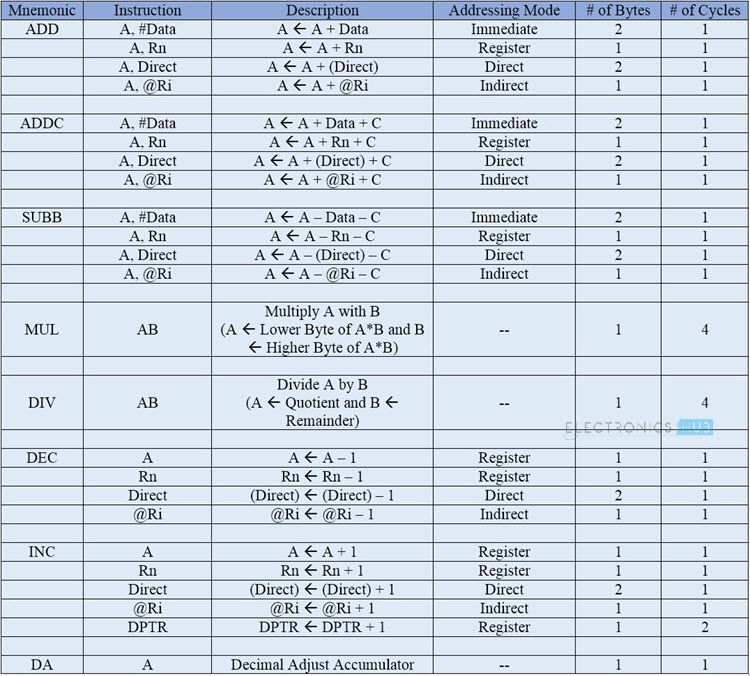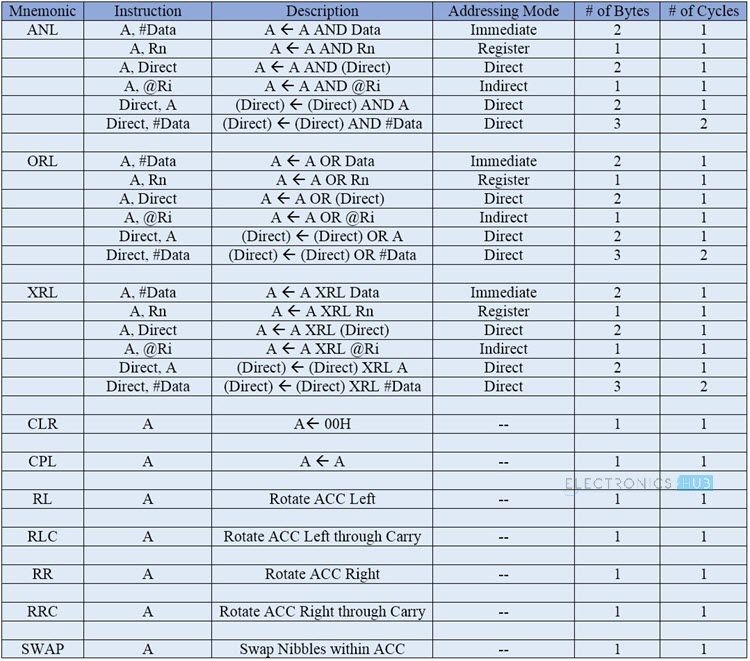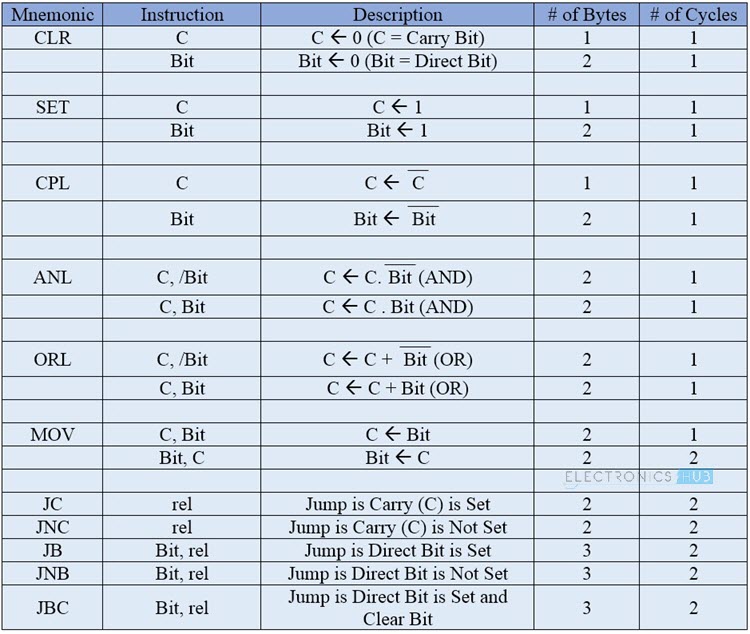Writing a Program for any Microcontroller consists of giving commands to the Microcontroller in a particular order in which they must be executed in order to perform a specific task. The commands to the Microcontroller are known as a Microcontroller’s Instructions Set.
Just as our sentences are made of words, a Microcontroller’s (for that matter, any computer) program is made of Instructions. Instructions written in a program tell the Microcontroller which operation to carry out.
An Instruction Set is unique to a family of computers. This tutorial introduces the 8051 Microcontroller Instruction Set also called as the MCS-51 Instruction Set.
As the 8051 family of Microcontrollers are 8-bit processors, the Instruction Set of 8051 Microcontroller is optimized for 8-bit control applications. As a typical 8-bit processor, the 8051 Microcontroller instructions have 8-bit Opcodes. As a result, the 8051 instruction set can have up to 28 = 256 Instructions.
Outline
Toggle8051 Microcontroller Instructions Sets and Groups
Before going into the details of the 8051 Instructions Set, Types of Instructions and the Addressing Mode, let us take a brief look at the instructions and the instruction groups of the 8051 Instruction Set (the MCS-51 Instruction Set).
The following table shows the 8051 Instruction Groups and Instructions in each group. There are 49 Instruction Mnemonics in the Instructions Set of 8051 Microcontroller and these 49 Mnemonics are divided into five groups.
| DATA TRANSFER | ARITHMETIC | LOGICAL | BOOLEAN | PROGRAM BRANCHING |
| MOV | ADD | ANL | CLR | LJMP |
| MOVC | ADDC | ORL | SETB | AJMP |
| MOVX | SUBB | XRL | MOV | SJMP |
| PUSH | INC | CLR | JC | JZ |
| POP | DEC | CPL | JNC | JNZ |
| XCH | MUL | RL | JB | CJNE |
| XCHD | DIV | RLC | JNB | DJNZ |
| DA A | RR | JBC | NOP | |
| RRC | ANL | LCALL | ||
| SWAP | ORL | ACALL | ||
| CPL | RET | |||
| RETI | ||||
| JMP |
Instructions Types In 8051 Microcontroller Instruction Set
Before seeing the types of instructions, let us see the structure of the 8051 Microcontroller Instruction. An 8051 Instruction consists of an Opcode (short of Operation – Code) followed by Operand(s) of size Zero Byte, One Byte or Two Bytes.
The Op-Code part of the instruction contains the Mnemonic, which specifies the type of operation to be performed. All Mnemonics or the Opcode part of the instruction are of One Byte size.
Coming to the Operand part of the instruction, it defines the data being processed by the instructions. The operand can be any of the following:
- No Operand
- Data value
- I/O Port
- Memory Location
- CPU register
There can multiple operands and the format of instruction is as follows:
MNEMONIC DESTINATION OPERAND, SOURCE OPERANDA simple instruction consists of just the opcode. Other instructions may include one or more operands. Instruction can be one-byte instruction, which contains only opcode, or two-byte instructions, where the second byte is the operand or three byte instructions, where the operand makes up the second and third byte.
Based on the operation they perform, all the instructions of 8051 Microcontroller Instruction set are divided into five groups. They are:
- Data Transfer Instructions
- Arithmetic Instructions
- Logical Instructions
- Boolean or Bit Manipulation Instructions
- Program Branching Instructions
We will now see about these instructions briefly.
Data Transfer Instructions of 8051 Microcontroller
The Data Transfer Instructions are associated with transfer of data between registers or external program memory or external data memory. The Mnemonics associated with Data Transfer are given below.
- MOV
- MOVC
- MOVX
- PUSH
- POP
- XCH
- XCHD
|
Mnemonic |
Description |
|
MOV |
Move Data |
| MOVC |
Move Code |
|
MOVX |
Move External Data |
| PUSH |
Move Data to Stack |
|
POP |
Copy Data from Stack |
| XCH |
Exchange Data between two Registers |
|
XCHD |
Exchange Lower Order Data between two Registers |
The following table lists out all the possible data transfer instructions along with other details like addressing mode, size occupied and number machine cycles it takes.

Arithmetic Instructions of 8051 Microcontroller
Using Arithmetic Instructions, you can perform addition, subtraction, multiplication and division. The arithmetic instructions also include increment by one, decrement by one and a special instruction called Decimal Adjust Accumulator.
The Mnemonics associated with the Arithmetic Instructions of 8051 Microcontroller Instruction Set are:
- ADD
- ADDC
- SUBB
- INC
- DEC
- MUL
- DIV
- DA A
|
Mnemonic |
Description |
|
ADD |
Addition without Carry |
| ADDC |
Addition with Carry |
|
SUBB |
Subtract with Carry |
| INC |
Increment by 1 |
|
DEC |
Decrement by 1 |
| MUL |
Multiply |
|
DIV |
Divide |
| DA A |
Decimal Adjust the Accumulator (A Register) |
The arithmetic instructions have no knowledge about the data format i.e., signed, unsigned, ASCII, BCD, etc. Also, the operations performed by the arithmetic instructions affect flags like carry, overflow, zero, etc. in the PSW Register.
All the possible Mnemonics associated with Arithmetic Instructions are mentioned in the following table.

Logical Instructions of 8051 Microcontroller
The next group of instructions are the Logical Instructions, which perform logical operations like AND, OR, XOR, NOT, Rotate, Clear and Swap. Logical Instruction are performed on Bytes of data on a bit-by-bit basis.
Mnemonics associated with Logical Instructions are as follows:
- ANL
- ORL
- XRL
- CLR
- CPL
- RL
- RLC
- RR
- RRC
- SWAP
|
Mnemonic |
Description |
|
ANL |
Logical AND |
| ORL |
Logical OR |
|
XRL |
Ex-OR |
| CLR |
Clear Register |
|
CPL |
Complement the Register |
| RL |
Rotate a Byte to Left |
|
RLC |
Rotate a Byte and Carry Bit to Left |
| RR |
Rotate a Byte to Right |
|
RRC |
Rotate a Byte and Carry Bit to Right |
| SWAP |
Exchange lower and higher nibbles in a Byte |
The following table shows all the possible Mnemonics of the Logical Instructions.

Boolean or Bit Manipulation Instructions of 8051
As the name suggests, Boolean or Bit Manipulation Instructions deal with bit variables. We know that there is a special bit-addressable area in the RAM and some of the Special Function Registers (SFRs) are also bit addressable.
The Mnemonics corresponding to the Boolean or Bit Manipulation instructions are:
- CLR
- SETB
- MOV
- JC
- JNC
- JB
- JNB
- JBC
- ANL
- ORL
- CPL
|
Mnemonic |
Description |
| CLR |
Clear a Bit (Reset to 0) |
|
SETB |
Set a Bit (Set to 1) |
| MOV |
Move a Bit |
|
JC |
Jump if Carry Flag is Set |
| JNC |
Jump if Carry Flag is Not Set |
|
JB |
Jump if specified Bit is Set |
| JNB |
Jump if specified Bit is Not Set |
|
JBC |
Jump if specified Bit is Set and also clear the Bit |
| ANL |
Bitwise AND |
|
ORL |
Bitwise OR |
| CPL |
Complement the Bit |
Also Check this: Bitwise Operators in Microcontroller Programming
These instructions can perform set, clear, and, or, complement etc. at bit level. All the possible mnemonics of the Boolean Instructions are specified in the following table.

Program Branching Instructions of 8051
The last group of instructions in the 8051 Microcontroller Instruction Set are the Program Branching Instructions. These instructions control the flow of program logic. The mnemonics of the Program Branching Instructions are as follows.
- LJMP
- AJMP
- SJMP
- JZ
- JNZ
- CJNE
- DJNZ
- NOP
- LCALL
- ACALL
- RET
- RETI
- JMP
|
Mnemonic |
Description |
| LJMP |
Long Jump (Unconditional) |
|
AJMP |
Absolute Jump (Unconditional) |
| SJMP |
Short Jump (Unconditional) |
|
JZ |
Jump if A is equal to 0 |
| JNZ |
Jump if A is not equal to 0 |
|
CJNE |
Compare and Jump if Not Equal |
| DJNZ |
Decrement and Jump if Not Zero |
|
NOP |
No Operation |
| LCALL |
Long Call to Subroutine |
|
ACALL |
Absolute Call to Subroutine (Unconditional) |
| RET |
Return from Subroutine |
|
RETI |
Return from Interrupt |
| JMP |
Jump to an Address (Unconditional) |
All these instructions, except the NOP (No Operation) affect the Program Counter (PC) in one way or other. Some of these instructions has decision making capability before transferring control to other part of the program.
The following table shows all the mnemonics with respect to the program branching instructions.

8051 Microcontroller Addressing Modes
What is an 8051 Addressing Mode?
An Addressing Mode is a way to locate a target Data, which is also called as Operand. The 8051 Family of Microcontrollers allows five types of Addressing Modes for addressing the Operands. They are:
- Immediate Addressing
- Register Addressing
- Direct Addressing
- Register – Indirect Addressing
- Indexed Addressing
Immediate Addressing
In Immediate Addressing mode, the operand, which follows the Opcode, is a constant data of either 8 or 16 bits. The name Immediate Addressing came from the fact that the constant data to be stored in the memory immediately follows the Opcode.
The constant value to be stored is specified in the instruction itself rather than taking from a register. The destination register to which the constant data must be copied should be the same size as the operand mentioned in the instruction.
Example: MOV A, #030H
Here, the Accumulator is loaded with 30 (hexadecimal). The # in the operand indicates that it is a data and not the address of a Register.
Immediate Addressing is very fast as the data to be loaded is given in the instruction itself.
Register Addressing
In the 8051 Microcontroller Memory Organization Tutorial, we have seen the organization of RAM and four banks of Working Registers with eight Registers in each bank.
In Register Addressing mode, one of the eight registers (R0 – R7) is specified as Operand in the Instruction.
It is important to select the appropriate Bank with the help of PSW Register. Let us see a example of Register Addressing assuming that Bank0 is selected.
Example: MOV A, R5
Here, the 8-bit content of the Register R5 of Bank0 is moved to the Accumulator.
Direct Addressing
In Direct Addressing Mode, the address of the data is specified as the Operand in the instruction. Using Direct Addressing Mode, we can access any register or on-chip variable. This includes general purpose RAM, SFRs, I/O Ports, Control registers.
Example: MOV A, 47H
Here, the data in the RAM location 47H is moved to the Accumulator.
Register Indirect Addressing
In the Indirect Addressing Mode or Register Indirect Addressing Mode, the address of the Operand is specified as the content of a Register. This will be clearer with an example.
Example: MOV A, @R1
The @ symbol indicates that the addressing mode is indirect. If the contents of R1 is 56H, for example, then the operand is in the internal RAM location 56H. If the contents of the RAM location 56H is 24H, then 24H is moved into accumulator.
Only R0 and R1 are allowed in Indirect Addressing Mode. These register in the indirect addressing mode are called as Pointer registers.
Indexed Addressing Mode
With Indexed Addressing Mode, the effective address of the Operand is the sum of a base register and an offset register. The Base Register can be either Data Pointer (DPTR) or Program Counter (PC) while the Offset register is the Accumulator (A).
In Indexed Addressing Mode, only MOVC and JMP instructions can be used. Indexed Addressing Mode is useful when retrieving data from look-up tables.
Example: MOVC A, @A+DPTR
Here, the address for the operand is the sum of contents of DPTR and Accumulator.
NOTE: Some authors and textbooks add few other Addressing Modes like Absolute Addressing Mode, Relative Addressing Mode and Long Addressing Mode.
Also read: 8051 MICROCONTROLLER ARCHITECTURE.
In this tutorial, we have seen the introduction to the 8051 Microcontroller Instruction Set, Addressing Modes in 8051 Microcontroller and different types of instructions in the Instruction Set of the 8051 Microcontroller.


22 Responses
Best tutorial. Well laid out making it digestible. Well done.
best
thank you
very helpful
Nice explanation of instruction set
very useful…all instruction set..thank you
Thank you for the instruction set, it is helpful.
Ya Its really useful and guided very much?
its very nice for notes preparation
Nice tutorial
Very nice tutorial…
This is amazing explanation,way better than those useless youtube lectures. Thank You !
VERY NICE TUTORIAL
Good easy understandable content…
Very helpful….
beautifully explained everything.
Very well explaination
And most helpful to study about instruction set of 8051
Thank you so much:)
Its very easly understand for your technical words
Helpful
Hi,
Very easy to understand .and very clear .
This is wonderful, I love the content. Keep up the good work it was really useful. Thank u…
very gud explntun luv it
Thank you very much